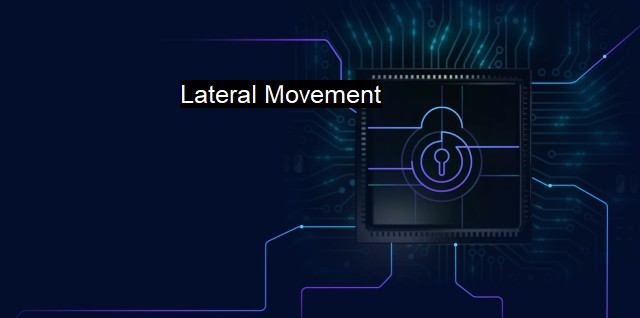What is Lateral Movement?
Lateral Movement Attacks: The Sneaky Cybersecurity Tactic that Bypasses Antivirus Software and Breaches Sensitive Networks and Resources.
Lateral Movement is a very crucial term in the context of cybersecurity and the operations of antivirus tools. To understand the concept thoroughly, first, let's keep in our mind the image of monitors displaying hacking codes and live tracking of intruders on a digital map often portrayed in movies. That's close to the real life concept of Lateral Movement, but there's more to it.Lateral movement is a technique that cybercriminals employ after gaining initial access to a network. The tactic involves making calculated steps inside this network to access critical internal resources. In other words, it's the act of progressing from the entry point of the system, or victim's computer, and moving sideways or moving externally to the target that holds valuable data to be exfiltrated or compromised.
It's akin to a burglar, who after breaking into a house does not immediately leave, but carefully moves room by room searching for valuable things. They incrementally increase their power in the home until they reach their final desired point, and similar footprints are seen in the field of cybernetics.
The primary goal of lateral movement within cybersecurity is the continuous surveillance of users, intellectual property, personally identifiable information, or financial information in the network surroundings by obtaining higher-level privileges. The information that the attackers gain can be used for nefarious acts such as ransomware attacks, network sabotage, or data theft, all of which can have devastating consequences on an individual, a business, or even an entire nation if planned on a larger scale.
A way through which these cybercriminals can initialize Lateral Movement is the Pass the Hash technique. This method is characterised by hash function attacks which authenticate passwords, instead of requiring the associated plaintext password as is typical. attackers also exploit compromised user's credential or use spear phishing, malware, and social engineering tactics to increase their foothold on systems and continually move from one point to another till they reach their target.
Appropriate antivirus solutions keep an eye on this intricate method of unauthorized network migration by monitoring systems behavior and report issues as soon as there is any sign of unusual activity. To counter lateral movement, these tools use 'Endpoint Detection and Response' (EDR) capabilities that are designed to detect, investigate, and neutralize any malicious activities on endpoints or network nodes.
Advanced antivirus softwares provide cybersecurity visibility, have functionalities to identify irregularities, and use machine learning and AI to recognize complex invasion patterns, thus resulting in better predictive threat intelligence and minimized false alarms.
In addition to antivirus countermeasures, network segmentation is a worthy approach against lateral movement. This involves dividing the network into sequestered parts, limiting communication paths, and hence controlling unwanted and unprecedented propagation incidents. Also, employing a 'least privileged' policy where a user is given minimum levels of access, or privileges, just enough to perform his job functions, can limit the reach of the attackers even if they gain access to one segment.
As technology advances and more business operations go online, the landscape of cyber-crime, particularly lateral movement, becomes ever-more intricate and potentially damaging. Awareness and vigilance are two essential components needed in anticipation of these threats. Therefore, it is positively pertinent for cybersecurity and antivirus mechanisms to continuously adapt and improve to match the evolving techniques of malicious hackers. They must be continuously updated and need to work beyond established parameters in order to mitigate risks and protect precious data from the imminent peril of cyber threats.

Lateral Movement FAQs
What is lateral movement in the context of cybersecurity?
Lateral movement refers to the technique used by cybercriminals to move across a network after gaining unauthorized access. The attacker can move laterally from one system to another in search of sensitive information or to launch further attacks.Why is lateral movement a significant threat to cybersecurity?
Lateral movement is a significant threat to cybersecurity because it enables attackers to move quietly across a network, making it difficult for antivirus software to detect and stop them. Once an attacker gains unauthorized access, they can move laterally with the goal of stealing data, crippling operations or destroying critical systems.What are some common lateral movement techniques used by attackers?
Attackers use a variety of techniques to move laterally across a network, including pass-the-hash attacks, remote desktop protocol hijacking, lateral spear-phishing, and exploitation of vulnerabilities in unsecured systems.How can organizations defend against lateral movement attacks?
Organizations can defend against lateral movement attacks by segmenting their network, implementing least privilege permissions, closely monitoring network traffic, regularly patching vulnerabilities, and using behavior-based detection and response tools. Additionally, ensuring up-to-date antivirus software is installed and kept updated can help to prevent attacks from compromising the system in the first place.| | A | | | B | | | C | | | D | | | E | | | F | | | G | | | H | | | I | | | J | | | K | | | L | | | M | |
| | N | | | O | | | P | | | Q | | | R | | | S | | | T | | | U | | | V | | | W | | | X | | | Y | | | Z | |
| | 1 | | | 2 | | | 3 | | | 4 | | | 7 | | | 8 | | |||||||